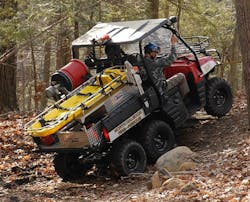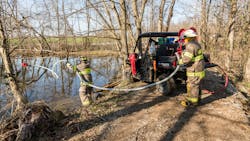UTV-Based Apparatus: A Little Rig for Big Jobs
For decades, to affect the rescue of a hunter down two miles in the woods, the toning of several departments to assemble a small army of first responders would be required. A similar battalion would be required to fight a remote wildland fire as well.
Concerts, festivals and large sporting events also require a lot of staffing simply to navigate through the crowds and narrow egresses.
The advent and proliferation of motorized all-terrain vehicles (ATVs) improved responses and eased personnel requirements.
More recently, utility task vehicles—or utility terrain vehicles—more commonly called UTVs, revolutionized the emergency response market with niche apparatus that can traverse areas too small for larger apparatus, providing quick access to remote patients or fire.
“Basically, the reason we’ve seen an explosion, and a very dramatic uptick in the use of UTVs, is because they are an excellent tool for those departments that are being significantly reduced in numbers, both volunteer and career departments,” said Kimball Johnson, president and founder of Kimtek Research, a manufacturer of UTV-based apparatus located in Orleans, VT.
Johnson, who recently retired as chief of Westmore Fire Rescue, a department he founded in 2000, knows firsthand what it takes to run an operation with limited staffing. It was often only himself and one other firefighter responding to remote calls for emergency medical services or brush fires.
“You can get to the core of the matter much faster with a UTV,” Johnson said, noting that UTV apparatus can be equipped with capabilities to transport EMS patients or to fight fire and, in many cases, to do both.
Johnson has seen UTV apparatus being deployed in urban settings with increasing frequency, including New York City, New Orleans, Chicago and a variety of suburban areas. They’ve also been used at five Super Bowl events and at 18 NASCAR events, Johnson said.
'They're worth a million bucks'
"They’re not going to go out every day, or every other day, but when they do go out, they’re worth a million bucks," Johnson said. "They are just so versatile, the things they can do."
He said departments should consider the variety of missions a UTV can perform when considering purchasing such an apparatus. They can be used at festivals, or to retrieve a walker who broke an ankle on a rails-to-trails path, he said, adding they can also extinguish fires set by smokers in the woods, or traverse beaches and marshy areas and also aid as a good public relations tool at social events.
Johnson said Kimtek apparatus are also deployed in all branches of the US military all over the world for fire suppression and medical responses.
“They see some pretty rugged conditions,” Johnson said. “It’s amazing how much they can do.”
Tony Stanley, who manages Government Development for Polaris Government and Defense, said UTVs are primarily designed for operation on unimproved terrain, “be it mud, mountains, sand, beaches, snow, ditches, fields or disaster areas.”
Polaris Industries is a UTV and ATV builder located in Medina, MN.
Stanley said the UTVs have the capabilities of navigating narrow trails or areas with lots of tree cover as well as man-made obstacles.
“In the city, or town, the vehicles can go up curbs and stairs, navigate disaster areas and go through parks, tight and sensitive areas like alleys, [and] crowded streets,” Stanley said. “Walkways and barricades are also more easily navigated with a small vehicle.”
In addition to providing a quick and effective response to emergencies, Stanley said UTV-based apparatus can also be used in fire prevention situations, including controlled burns, fire watches, fire break maintenance and upkeep. In addition, they're used to transport personnel and equipment in urban and rural areas as well as supporting search and rescue missions and disaster relief.
'UTVs are very versatile'
Jim Burge is the vice president of marketing and business development for CET, a fire equipment and fire pump manufacturer based in Piereville, Quebec, Canada.
“UTVs are very versatile,” Burge said. “The use of an UTV/ATV for emergency response is really only limited to the imagination of the agency that needs to respond to places that are difficult to reach with traditional apparatus.”
When it comes to selecting the best apparatus type and driveline, there are many things firefighters need to consider.
Johnson said earlier UTVs were strictly gasoline driven, but now there are diesel units that have plenty of power and speed and are a good option for some departments, especially those with other diesel-powered apparatus.
Stanley said Polaris has both diesel and gasoline units as well as electric units which are suitable for indoor operations. He said the electric units “better manage emergency situations for indoor and closed campus applications.”
“The GEM eLXD is an all-electric and street legal option that also improves department sustainability,” Stanley said.
Burge said there are a number of factors to consider including the speed in which the UTV needs to travel. “Gasoline or diesel,” Burge said. “Do you want the same as your [on-board] pump for simplicity of refueling?”
He also said firefighters should consider the location where the UTV is expected to traverse and whether or not it will be required to respond to the scene on its own power or whether it will be traveled to a launch area.
Burge also said firefighters need to think about the electric draw on batteries on the UTV for lights and equipment. If there’s a lot of demand for electricity, Burge said diesels generally have more power to operate that kind of equipment.
“All things to consider,” Burge said.
Driveline Considerations
Johnson said there are some subtle things firefighters need to consider like whether the UTV will be belt driven or if it should have a fully enclosed transmission which is more appropriate for wet, marshy environments as well as sandy conditions.
Johnson also said that when UTVs are employed as response apparatus, they often need suspension bolstering, a modification he does whenever he builds a new apparatus. He said it’s not expensive and well worth the cost considering the weight the UTV-based apparatus will be asked to carry, which is considerably more than the versions purchased by “weekend warriors” who use them for recreation or to get in and out of remote camps.
“Those are the types of things to think about,” Johnson said, adding that geography and topography should also be considered when specifying apparatus. The hills and valleys of Utah might require different specifications than flat ground found Florida, for instance, Johnson pointed out. “The best thing is to have the department work real close with the local [UTV] dealer,” Johnson said. “We need to very seriously consider the choice of the UTV chassis for the mission it is going to be asked to serve,” he said.
There are several UTV chassis builders, Johnson said, noting that all provide good bases for apparatus. Polaris, Kubota, Gravely and more recently Mahindra, are all offering robust chassis upon which to build apparatus, Johnson said.
After the chassis are selected, the response apparatus need to be added and that’s when the departments will need to decide the mission.
Virtually all UTV-based apparatus manufacturers will offer components for straight rescue and patient transport and straight fire suppression. Some will offer combinations units that will do both.
Johnson said it’s common to have vehicles that transport victims as well as boast some fire suppression capabilities. The key is to have a balance and not ask the apparatus to do more than what it designed to do, the experts agreed.
Johnson said there has to be a balance of equipment, on-board water, as well as passengers and patient weights to consider.
“You never want to be in a position of asking it to do more than it should,” Johnson said. “It’s a matter of safety.”
And when it comes to safe operation, the rules are the same as with larger apparatus, the experts said.
“Proper vehicle operation is critical, especially in emergency situations, and UTVs are no different,” Stanley said. He said UTV operation is intuitive and easy to operate, but Polaris Government and Defense offers training so everyone can be familiar with the capabilities of the vehicles and understand safety and maintenance issues.
“There are also vehicle characteristics that increase safety, such as the [Polaris] Ranger’s speed governor if the driver’s seat belt isn’t buckled,” Stanley said.
Safe Operations
Johnson said one of the biggest keys to safe operations is to maintain reasonable speeds. Some of the newer UTVs are capable of traveling at speeds up to 60 mph, Johnson said.
“I am not a big fan of those speeds,” Johnson said. “At those speeds, someone is going to get hurt.”
He added that speeds of about 35 to 42 mph is more reasonable for top speeds in most cases. In some cases, 10 mph might be too fast, especially with a patient on board being treated or in extremely rocky terrain.
“If it’s too bad, you might have to stop and say ‘we’re hoofing it in the rest of the way,’” Johnson said, noting that the UTV still saved time by getting the crews and/or patient some portion of the way in. It’s better to be safe than sorry, Johnson recommended.
Johnson said his company has comprehensive safety manuals and training available to ensure safe operations. That training includes some of the less obvious pointers like the need to slow down while cornering on hard surfaces and pavement, he said.
“You have to remember they’re built for turning on loose gravel, that’s their natural habitat,” Johnson said. He added on hard-packed surfaces and pavement they might grab the surface and become less stable creating a chance for roll-over.
Johnson said he most fears the “weekend warriors” who are used to UTVs as recreational vehicles and doing daredevil stunts like jumping and driving at excessive speeds.
“Firefighters need a huge, huge dose of common sense,” Johnson said, adding that officers might have to “do one thing that they won’t want to do unless you force them and that is go line by line over the manufacturers’ chassis and body manuals. …You’ve got to get that chip off the weekend warrior.”
Burge agreed.
“Don’t try to exceed what the unit can realistically do,” Burge said. “Keep common sense in mind along with your normal SOPs.”
And despite all their versatility, UTV-based apparatus have some limitations.
“UTV-based apparatus won’t take the place of full-sized fire and rescue vehicles, but rather augment a fleet with unique added capabilities,” Stanley said.
To make up for some of that limitations, Kimtek, Polaris and CET all supplement the on-board water supplies they each carry with optional foam systems to stretch the fire suppression capabilities.
Maximize Efficiency
Stanley said Polaris’ Ranger and Pro XD series UTVs have 67-gallon water tanks with three gallon foam cells and the ability to draft water up to 18 vertical feet – all to maximize efficiency.
In regards to patient care and transport, Johnson said responders need to remember “it’s not a full-blown ambulance” with all the capabilities and abilities to take a patient from the scene to the hospital. They’re meant to send a couple of people out to get patients, package them and get them back to an awaiting ambulance for further treatment and transport.
“A lot of departments use them for that and love them,” Johnson said.
And regarding limitations, Burge said responders need to be realistic about weight limitations and carefully consider occupant load, water and equipment loads and where it will be operated. He added departments should also keep in mind whether the unit will be stationed, ready to go in a response area or if it will need to be trailered to a location for use.
With the proliferation of UTV-based apparatus, there have been some refinements and trends pointing to their future use.
“The biggest trend now is crew units, with up to six passengers and a very good cargo capacity,” Johnson said. The crew units are good “people movers” that are good for investigations, such as an aircraft crash, or a wildland fire where lots of people are needed in otherwise in accessible areas.
Stanley also said he’s noticed a trend that customers are buying larger, crew cab units, especially ones that have heating and air conditioning systems.
“The HVAC units are popular for the ability to regulate the temperature inside the Ranger in case they have a patient or a first responder who needs heat/AC,” Stanley said.
Stanley also said he’s noticed more customers are looking for “turnkey solutions right from the manufacturer, which Polaris provides.”
And Burge has noticed a trend in simply the number of them being put in service every year.
“The more they are used, the more new applications are thought of,” Burge said.













